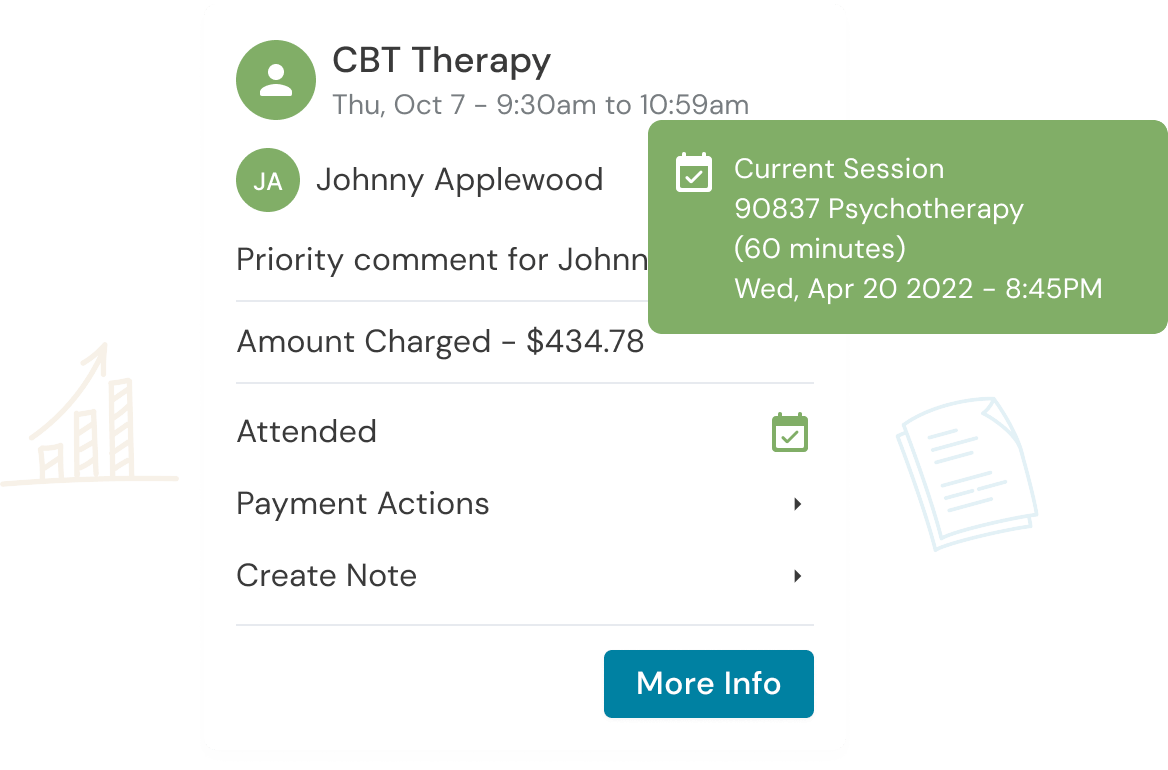While a personalized online presence helps empower a prospective client to reach out, nothing beats a one-on-one conversation.
When done well, the initial call with a prospective client moves beyond simply covering logistics. Those 10 to 20 minutes provide the client a taste of what it might be like to work with you in person.
Use these six strategies to nail your first contact with a prospective client and help them move from a hesitant foot in the door to a motivated, repeat client!

1. Send an introductory email before your phone call
Share practice details transparently and upfront with clients in a manner that conveys you have their best interests at heart.
The most efficient way to do this is in an email ahead of time. That way, you can spend valuable phone time getting to know the client, and showing them what it would be like to work with you.
You only need to write one templated email response to reuse and tweak for every new prospective client. If you have Gmail, you can use its ‘Canned Responses’ tool.
Example email response to a prospective client:
Hi Jane,
Thank you for reaching out! I’m looking forward to learning what’s bringing you to therapy and discussing how I may be able to help. To be respectful of your time, below is some basic information about my practice that may be helpful.
I currently have availability for daytime appointments between 11am and 2pm. I’m also not in-network with insurances, meaning you would pay the session fee at the time of the appointment and later seek reimbursement from your insurance company. I saw you have BCBS; you can see if you have out-of-network coverage by logging into the insurance company website or by calling the number on the back of your card.
I’m of course happy to answer any questions you have when we speak, too. Let me know if I can help in any way in the meantime!
– Maggie
As a client, there’s nothing worse than reaching the end of a conversation, being really excited to work with a therapist, and then discovering that insurance, fees, or scheduling limitations makes it logistically impossible.
At that point, you’ve also wasted your own time, energy, and emotional bandwidth talking with an individual who isn’t going to become a regular client. Skip this unnecessary hassle by sending out an intro email ahead of time!
2. Ask gentle, personalized questions
Remember that clients have different degrees of experience with therapy.
While experienced therapy-goers may know exactly what they want, people who have never been to therapy before may have misconceived notions about what it will be like, anxiety around sharing their private life, and questions about effectiveness.
Acknowledge these concerns, but do your best to assuage them with thoughtful, gentle questions that recognize the client is the expert on their own life:
- Why are you considering therapy now?
- What does [stress/ anxiety / panic] look like for you?
- What do you think you need to move from where you are now to where you want to go?
Be informed going into the call, too. If the client shared why they’re seeking therapy in a prior email or initial call request form, refer to the challenges they mentioned to show you’ve already dedicated thought into their unique situation.
It’s important to have a clear understanding of the client’s needs before elaborating on yourself so that you only supply the most relevant, compelling information.
3. Make your value as their prospective therapist clear
Therapy, like any other service or ongoing expense, is an investment. By the time of the initial phone call, the client has already decided they want to seek therapy; what they have not decided is who their therapist will be.
It’s your job to show the client you are the best possible therapist for them. Clearly explain what working with you as their therapist will look like. Include:
- The structure of your typical sessions
- How you will provide symptom relief
- How you help them reach their therapy goals
- How long clients typically work with you
Tailor the conversation as much as possible, using the words they use to describe challenges and focusing on their individual experience.
4. Describe your approach in shared language
When discussing your therapeutic approach with clients, it’s best to speak in terms of the relationship you seek to build with them. While it may be common for you to describe your work in clinical terms, speaking in shared language helps clients understand you’re ready to meet them where they are.
Here are two examples of common approaches, and how you can easily swap them out for descriptive language that’s tailored to the client’s needs:
- Cognitive Behavioral Therapy: “I use an approach called Cognitive Behavioral Therapy, which helps individuals build concrete skills to manage difficult thoughts or behaviors. For example, to reduce the stress and anxiety you’ve been feeling recently, we might focus on increasing awareness of where you are when these emotions arise and examining how your thought patterns change during stressful times. We’ll practice coping skills, such as how to reframe these negative thoughts, and I’ll give you strategies to try outside of session, so we can ensure the work we do here is applicable to your daily life and ultimately helps you tackle stress on your own.”
- Psychodynamic therapy: “I’m trained in psychodynamic therapy, which means our sessions focus on understanding and processing past events and how they’re affecting you now. You mentioned you’re interested in discussing relationship challenges you’re experiencing with your family. In addition to working to overcome the specific communication barriers you’re dealing with now, we’ll also look at what’s going on beneath the surface, and how patterns and expectations developed in the past may be influencing your current relationships. The goal is to reach a point of understanding so that when these communication issues arise in the future, you’ll be better equipped with knowledge of the roots of the problem and be able to have more compassion for yourself and everyone involved.”
5. Ask the client how they’d like to proceed
Ending the initial call on a positive, thoughtful note is just as important as the rest of the consultation.
At the end of the call, ask: “Do you have other therapists you’re speaking with or would you like to schedule an in-person appointment now?”
This gives clients a chance to politely decline scheduling an intake, or to reflect on the conversation and get back to you later.
6. If the client confirms, be sure to follow up!
If the client does want to move forward, send them a confirmation email or text with your address, phone number, and the date and time of the appointment. This vastly reduces no-show rates and decreases the chance of your new client writing down the appointment details incorrectly.
And remember, even if the client ultimately decides not to move forward with you as their therapist, having an initial call that stands apart from the crowd is powerful. Wowing a client during an initial call has the potential to generate word of mouth referrals (e.g. “I ended up not seeing this therapist, but she was great on the phone”), and elevates your position as a top therapist within the community.

Are you a new practice? Start with Owl.
Reduce clinical administrative tasks and transform more lives with Owl Practice. Owl Practice provides all the tools you need to make your practice successful. Join the thousands of care professionals using Owl to run their practice every day.



